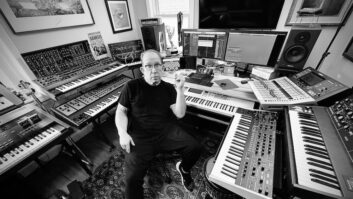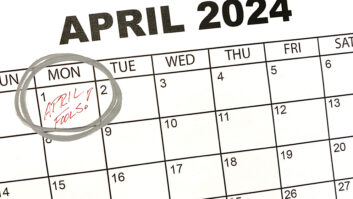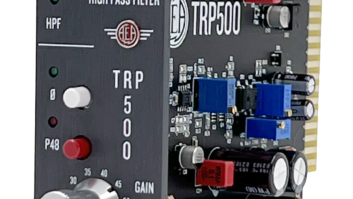
For those of us engaged in professional recording on a daily basis,
the availability of “classic” microphones is often more of a necessity
than a luxury. Even with the development of ultraquiet and linear
microphones, engineers often look to the tried-and-true for the
character of sound that is most appropriate to the task. We have seen a
resurgence of tube microphone designs in recent years: There have been
re-creations of classic designs such as the AKG C 12 (C-12 VR) and D 12
(D-112), along with the Neumann U67 and M49 (M149). I’ll leave it to
the reader to judge the success of each of these designs.
Now, Audio Engineering Associates (AEA) offers the R44C, a
re-creation of the RCA 44BX classic ribbon design from the 1930s. This microphone was
originally released in 1936 as the 44B and revised to its current,
basic design as the 44BX in 1938. In the ensuing years, RCA became an
industry leader in the design and manufacture of ribbon microphones,
including the 77C/ 77DC/BK-5/KU3A, among others.
From the outset, the 44BX was used for music and dialog recording.
The bi-directional pattern was useful for recording ensembles using
both sides of the microphone for balance while preserving visual
contact between musicians. The 44BX soon became a standard for voice
reproduction in the broadcast industry. With its generous proximity
response (effective within two meters), it gave most voices a warm and
appealing presence without accentuating sibilance. Various
modifications to the basic 44BX design during the years provided for a
response dip in the 9kHz range and a physical modification to the
connectors, casing and mounts.
The RCA ribbon mic line was—and remains—well known to
the film industry. Most scoring stages acquired large stocks of ribbons
directly from RCA during the 1930s and ’40s. Although many of
these microphones are now in the hands of collectors, there are still a
number in use to this day on scoring stages and by scoring mixers in
the film industry. While at Disney Studios in the 1980s, I was pleased
and surprised to see more than 30 RCA KU3A microphones in the locker,
with 18 in perfect working order. The Todd-AO scoring stage (with which
I am now associated) possesses several KI-3A microphones. Though the
Coles 4038 and Beyer M160/M130 have somewhat supplanted the older RCA
units as current workhorses, most engineers would gladly use a good
44BS/77DX/KU3A for the appropriate recording task.
AEA has been a supporter and supplier of ribbon microphones to the
audio/film industries for a number of years. The company imports the
classic and still-produced Coles 4038 and provides mounts/connector
modifications and service support. Now, AEA has undertaken the daunting
task of re-creating the RCA 44BX exactly as the AEA R44C ($2,000).
Unlike some re-creations that sound alike, but do not look
alike—or vice versa—this microphone looks, feels and sounds
like the original. I had the opportunity to try this unit and compare
it with two of my original 44s.
My first project was re-recording the classic Bernard Herrmann score
for Psycho; the score was produced by Danny Elfman. The intent
was to create a sound picture that was at once modern and classic
through the use of high-quality overall treatment, along with spot
microphones that would give the score a more “traditional” feel. We
decided to use a normal M50 Decca Tree plus outriggers for the main
pickup, but then we’d use only ribbons for close of spot pickup and to
balance these elements roughly 50/50. We chose the Coles 4038 for
violins, Beyer M130 for violas, Beyer M160 for cellos and RCA 44BX for
basses. I was able to compare the AEA R44C directly to my two older 44s
and found the sonic character to be identical. The level match was very
close: Less than 2 dB separated the three units. We also did some
quick listening tests with the 44BX on violins, which were very
favorable. (We would have needed at least one more to actually record
the score using these microphones in this position.)
My next project was recording John Williams’ score for
Stepmom. We used the R44C on trumpet, a standard microphone
choice for many scoring mixers. In this application, the microphone
performed flawlessly. Its smooth ribbon character and overall warm
sound were perfect for this application. In fact, I would
unhesitatingly use these microphones for most brass applications.
I should note that microphone preamps lend a great deal of character
to the sound of ribbon microphones. The classic Neve 1073 and 1081 have
always performed well, along with the more contemporary Boulder/Hensen
990 and Grace units. All of the above preamps have been designed with
ribbon microphones in mind and with the high gain settings vs. noise
and stability as important criteria. Note that it is always best to
disable the phantom power well before connecting a ribbon
microphone to a preamp input.
The availability of a new/old 44BX is most appealing. Even though
the Coles 4038 has served well as a substitute, there is a sweetness
and beautiful authority to the 44 sound that has not been re-created
until now. As so many of the original units are in disrepair or out of
service, the availability of a new microphone with these
characteristics is very welcome. In all, the AES R44C is a very
successful re-creation, one of the best in current memory.
Audio Engineering Associates, www.wesdooley.com.







